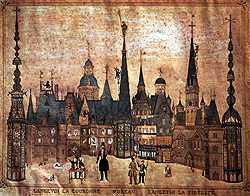|
|
 |
 |
 |
|
A
young craftsman (drawn to a much larger scale than the other figures)
leaves his native town in order to achieve his skills as a journeyman
by a Tour of France. Pen drawing with watercolor. around 1840.
|
|
In every instance
where (an) article is made in the home, the relationship between the master
who possesses the technical skill and the apprentice to whom it is imparted
is a complex one. They may be related by bloodfather-son, mother-daughter,
oldest son-youngest son- or by position in the household -master-servant,
old retainer-master's son, etc. -with all of the dissymmetry implicit in
the latter. The transfer of skills is never haphazard; the network it follows
has a sequential structure. Hence it is by no means accidental or owing
to some mysterious inertia that works produced in the home perpetuate ancient
techniques and skills long forgotten elsewhere, but, rather, because of
the structure of domestic relationships. To be sure, the conditions of home
production are not such that each unit functions as a Leibinitzean monad,
a closed world, a microcosm within the macrocosm. The group of people engaged
in the production of an article may-especially in winter-include friends
and neighbors. In this case, skills can be exchanged within a structure
of symmetrical relationships. Young men leave home, either for military
service or to serve their apprenticeship, and come back with new skills
to teach their relatives- skills developed in other places and according
to other norms. But techniques learned in the army or in a workshop or factory
are generally different in kind and cannot be passed on for home production
without considerable modification. The regimental forge or the saddlery
of a cavalry squadron do not provide viable models. The more specialized
the methods of production these young men are exposed to, the less easily
they can be adapted to the home. Hence the conditions that preserve skills
unchanged are the same ones that prevent the learning of new skills from
the outside world. Everything conspires to make home production a conservatory
of skills and customs.

|



